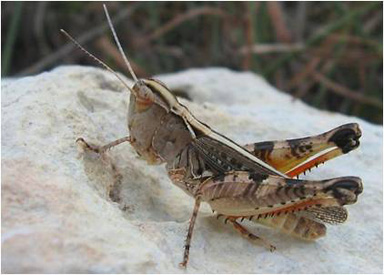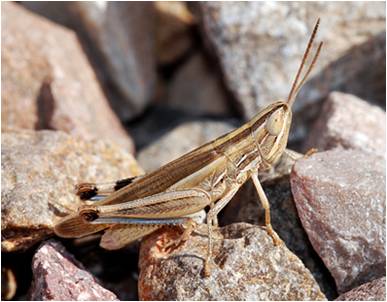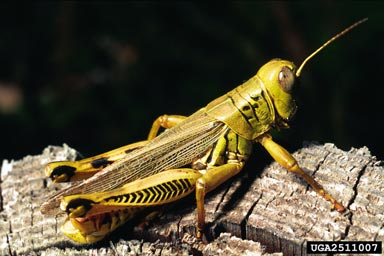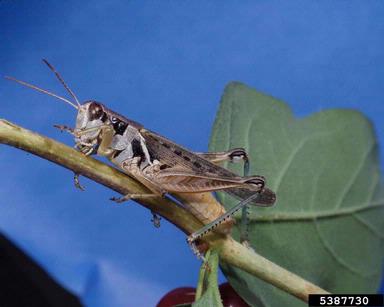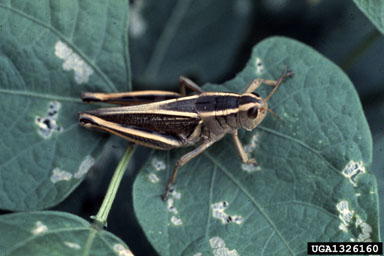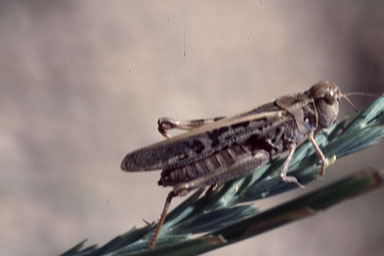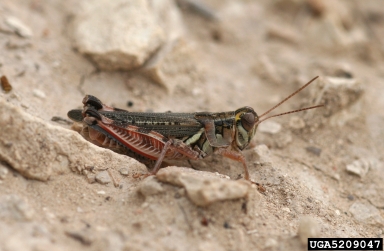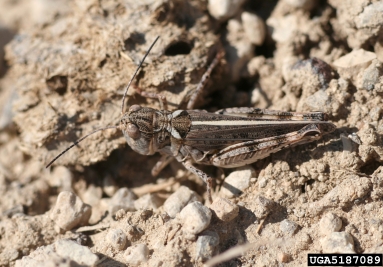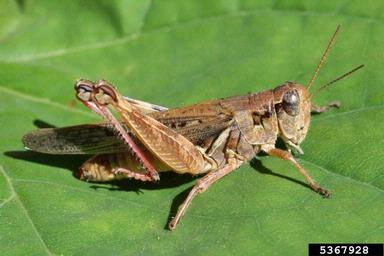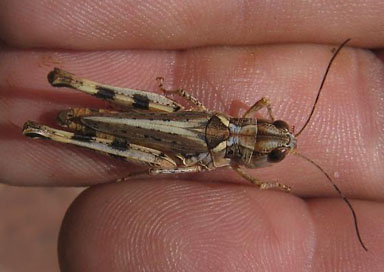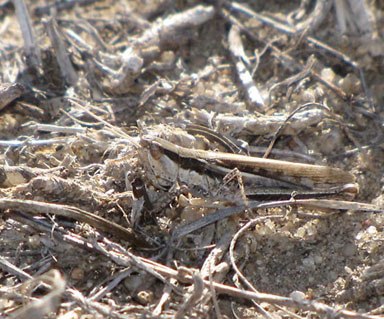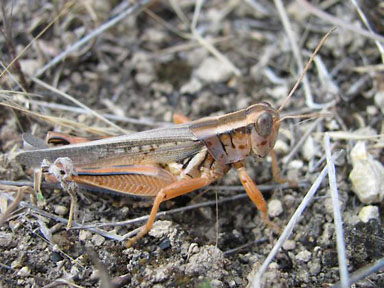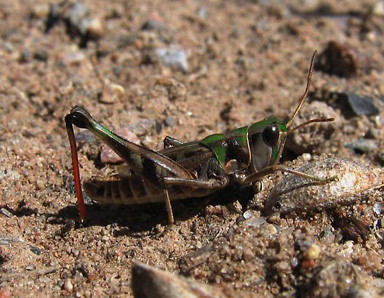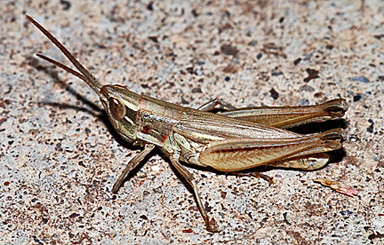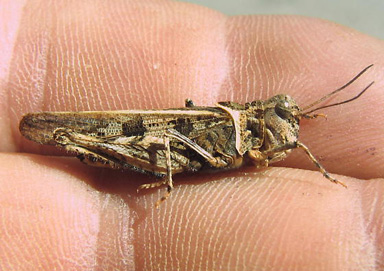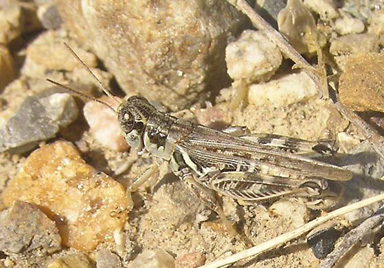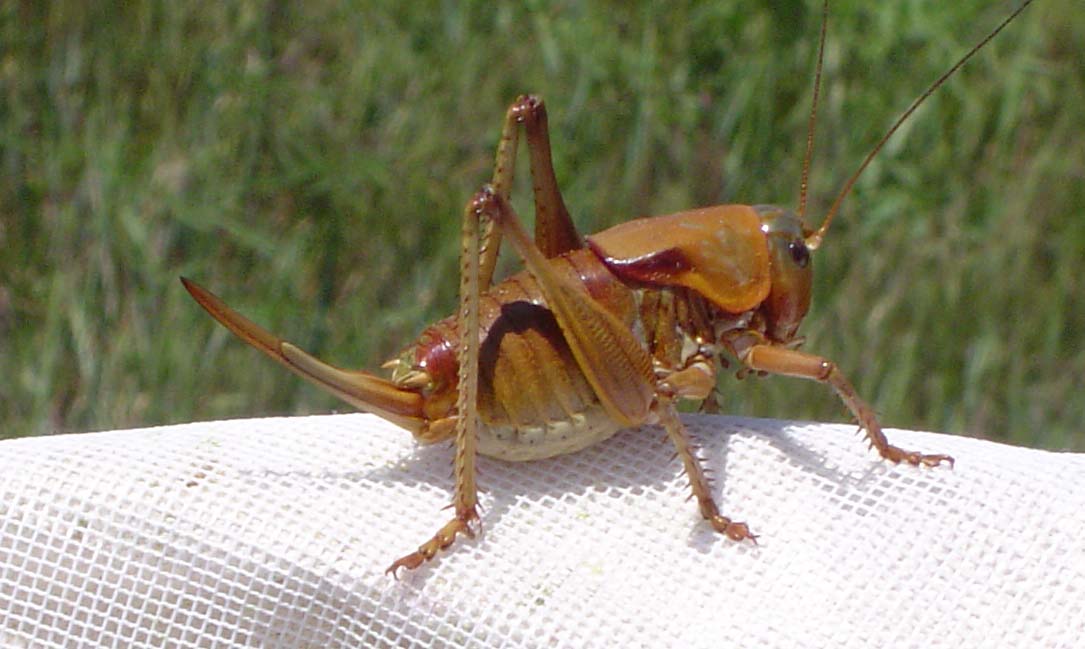Test Your Knowledge
Wyoming Cooperative Agricultural Pest Survey
Quiz: Grasshopper Pests
Hover mouse over photo for answer
Habitat: Sandy soils with sparse vegetation; blowouts, abandoned fields, native grasslands
Food: Grasses, sedges, dry plant debris
Importance: Can cause serious damage to vegetation
Seasonal History: July – mid October in Wyoming
Photo by: Paul Lenhart
-------------------------------------------------------------------------------------------------------------------------------------------------------------------------------
Habitat: Dry, grassy slopes. Small, grassy spots along river valleys
Food: Gramnivorous
Seasonal History: Late June - early October
Importance: Can cause heavy losses to native grasslands
Photo by: Robert A. Behrstock, Naturewide Images
-----------------------------------------------------------------------------------------------------------------------------------------------------------------------------
Habitat: Cultivated crops growing on low, moist ground and plowed fields.
Food: Mixed food, prefers grasses and juicy foods: corn, clover, alfalfa, and various garden
plants
Seasonal History: Late July
Importance: Destructive pest of crops and suburban areas
Photo by: David Riley, University of Georgia, Bugwood.org
------------------------------------------------------------------------------------------------------------------------------------------------------------------------------
Habitat: Grasslands, meadows, abandoned croplands that immediately turn to weeds
Food: Forbs, grasses, crops, small grains
Seasonal History: First part of summer
Importance: Attacks everything! Causes more damage than all other grasshoppers
Photo by: Joseph Berger, Bugwood.org
----------------------------------------------------------------------------------------------------------------------------------------------------------------------------
Habitat: Tall grass prairie, wet meadows, roadsides, ditches, banks, and crop borders
Food: Grasses, cereals, forbs, dry litter
Seasonal History: Migratory behavior, early emergence
Importance: Destroys crops and wastes more than they eat
Photo by: Whitney Cranshaw, Colorado State University, Bugwood.org
-------------------------------------------------------------------------------------------------------------------------------------------------------------------------------
Habitat: Short, thick grasses of damp meadowlands among hills and mountains. Sometimes grain fields, gardens and pastures
Food: Gramnivorous
Seasonal History: Late June – Late August
Importance: Higher altitudes in CO; Will cause damage to grains and range grasses.
Photo by: Whitney Cranshaw, Colorado State University, Bugwood.org
----------------------------------------------------------------------------------------------------------------------------------------------------------------------------
Habitat: Mixed grass and short grass prairies; rare in the desert
Food: Mixed feeder, prefers forbs and prickly pear
Seasonal History: Late June - August
Importance: Can do significant damage to rangeland and prickly pear
Photo by: Whitney Cranshaw, Colorado State University, Bugwood.org
-------------------------------------------------------------------------------------------------------------------------------------------------------------------------------
Habitat: Rangelands; sometimes deserts
Food: Many grass species
Seasonal History: Mid-June through September
Importance: One of the more damaging species to forage in Wyoming
Photo by: Whitney Cranshaw, Colorado State University, Bugwood.org
-------------------------------------------------------------------------------------------------------------------------------------------------------------------------------
Habitat: Dense stands of grass and weeds, cultivated fields, field margins, roadsides, pastures,
meadows - usually near water
Food: Grasses, alfalfa, sweet clover, vetch
Seasonal History: July to the first frost
Importance: Intermediate host to poultry tapeworm and globular stomach worm; sometimes a suburban
pest
Photo by: Russ Ottens, University of Georgia, Bugwood.org
-------------------------------------------------------------------------------------------------------------------------------------------------------------------------------
Habitat: Grasslands; mixed grass prairies
Food: General grass feeders
Seasonal History: Hatches 1-2 weeks after A. elliotti; First week in June
Importance: Feeds on valuable forage
Photo by: David Ferguson
-------------------------------------------------------------------------------------------------------------------------------------------------------------------------------
Habitat: Grasslands, mixed grass, short grass, desert, and bunchgrass prairies
Food: Green leaves of grasses, sometimes forbs and ground litter
Seasonal History: Late June - August
Importance: Pest of rangeland grasses and sometimes mixed prairies
Photo by: Eric Eaton
-------------------------------------------------------------------------------------------------------------------------------------------------------------------------------
Habitat: Field margins, roadsides, undisturbed prairies
Food: Form feeder, prefers many legumes
Seasonal History: Late July - early September
Importance: Rarely damages rangeland; more a pest of alfalfa and crop field margins in combination
with other species
Photo by: Paul Lenhart
-------------------------------------------------------------------------------------------------------------------------------------------------------------------------------
Habitat: Native prairies
Food: Exclusively grasses
Seasonal History: Mid July - late August
Importance: Can be a pest of forage
Photo by: David Ferguson
-------------------------------------------------------------------------------------------------------------------------------------------------------------------------------
Habitat: Grasslands, short and mixed grass
Food: Grass feeder
Seasonal History: Late July or early August
Importance: Ingests some of the plant; wastes plant matter by cutting and dropping
Photo by: Robert Behrstock, Naturewide Images
-------------------------------------------------------------------------------------------------------------------------------------------------------------------------------
Habitat: Sparse grasslands, mixed prairies
Food: Grasses, sedges, blue gamma
Seasonal History: Late June - on
Importance: Feeds on high quality forage grasses and sedges, becomes injurious to mixed grass
prairies
Photo by: David Ferguson
-------------------------------------------------------------------------------------------------------------------------------------------------------------------------------
Habitat: Dominant grasshopper in grasslands; Cold weather tolerant
Food: Grasses, forbs, rangeland
Seasonal History: Hatch late May - mid June
Importance: Threat to rangeland habitat
Photo by: James Bailey
-------------------------------------------------------------------------------------------------------------------------------------------------------------------------------
Habitat: Rangeland dominated by sagebrush and forbs
Food: Succulent forbs and shrubs
Seasonal History: May - September
Importance: Significant damage to rangeland and agriculture during migration
Photo by: Bruce Shambaugh, USDA-APHIS, PPQ

